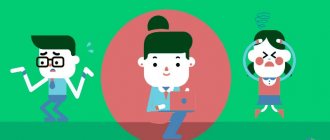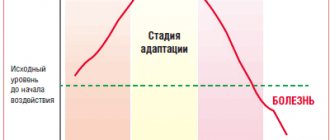Before we tell you how to treat neurasthenia, you should first understand what it is and what the symptoms of this pathological condition are.
Neurasthenia or asthenoneurotic syndrome is the most common type of mental disorder with mild changes. In essence, this is a severe depletion of the nervous system. Due to the similarity of symptoms, it is sometimes identified with chronic fatigue syndrome, however, as recent studies have shown, these conditions have different origins, so the treatment should be different.
A breakdown of the nervous system, which is neurasthenia, is a reversible phenomenon, regardless of how intensively and for a long time the manifestations of this syndrome were observed. It occurs without severe personality disorders and psychosis. But the person is well aware of his condition and tolerates it quite hard, which worsens the quality of his life.
Asthenic neurosis occurs due to some situation that traumatizes the psyche, coupled with chronic “lack of sleep” or a lack of other physiological needs, as well as overload of the body. To these factors are added various painful conditions, including infections.
Both men and women are equally susceptible to the disorder, but in the latter, due to the burden of various pathologies, it is more severe. As for the age limit, the majority of cases are people over 25 years old. This disease even received the “popular” name “manager’s syndrome.” But our fast-paced era has made its own adjustments: due to the complex school curriculum, intellectual and sports activity, representatives of the current younger generation also began to be diagnosed with neurasthenia.
It would be a misconception to believe that asthenoneurotic syndrome is characteristic only of residents of large cities. It’s just that people living in small settlements, including villages, are accustomed to attributing all health problems of this kind to simple fatigue, laziness, and bad character. Meanwhile, neurasthenia awaits every person.
Content:
- Stress and its types Positive and negative stress
- Psychological and physiological stress
- Physical (physiological) stimuli
- Alarm stage
- How to quickly relieve stress and calm your nerves?
Calligraphy
Calligraphy can hardly be called a new hobby: it has been around as long as writing. However, periodically the art of beautiful writing becomes fashionable, and now is just that time. Not the least role in this was played by the artist Pokras Lampas and his movement of calligraphic futurism.
Paint Lampas for Nike, pokraslampas.com
What you need to get started
Pablo Picasso mastered the classics before moving on to cubism. This approach will also work in calligraphy. Even if you want to say a new word in art, you should start with the basics.
You will need pens, a pen holder, ink and paper. A set of basic exercises with detailed explanations can be easily found on YouTube.
Stress and its types
Stress (from the English stress) is a complex of reactions with which the body responds to tension arising under the influence of unpleasant factors. The stress can be both physical and psychological: emotional or informational. The same word refers to the state of the nervous system and body in response to stressors - negative factors.
Positive and negative stress
Eustress is a type of stress that has a positive effect on a person. It improves tone and mood, makes you mobilize and act more effectively.
Types of eustress:
Positive
Under its influence, a person experiences many positive emotions: from simple pleasure to a feeling of happiness. It is usually caused by events that a person evaluates as pleasant: receiving gifts, meeting friends, love, family or personal joys, creative insight.
Mobilizing
This stress forces a person to “get it together,” to act most effectively, so as to solve the problem as quickly as possible, to get out of a difficult situation. If stressors disappear and there is an opportunity to relax, this type of stress will become beneficial.
Distress is “harmful” stress, that is, a dangerous state for the body when nervous tension is prolonged. The longer the effect of a harmful factor persists, the stronger and more unpleasant the consequences become. Strength is gradually depleted. In a state of prolonged nervous stress, a person is at risk of deteriorating not only his well-being, but also his health.
Psychological and physiological stress
Physiological stress is “triggered” under the influence of reasons that are associated with physical effects on the body. As a rule, this is cold or excessive heat, hunger, pain, too much noise, etc. In response, the functioning of the physiological systems of the body changes.
Psychological stress occurs under the influence of mental factors. In turn, it is also divided into emotional and informational:
- Information stress occurs under the influence of a large flow of information that a person does not have time to cope with. Inability to make decisions, great responsibility for the lives or health of other people, too much data - all this leads to a state of stress.
- Emotional stress is a condition that arises under the influence of some events or our experiences. This type of stress will more quickly lead to moral exhaustion than physical exhaustion. However, psychosomatic diseases - diseases of the body - can also arise under the influence of emotional factors.
Podcasting
Podcasts are specially recorded shows in audio format. They appeared in the early 2000s, then began to lose popularity, and are now experiencing a renaissance.
Podcasts can not only be listened to, but also recorded. This hobby is suitable for those who like to broadcast to the public in one way or another. At first, LiveJournal and other blogging platforms were used for this, then social media feeds, Instagram and YouTube accounts.
It’s most logical to compare podcasting to creating your own YouTube channel. The same transmission, only the entry threshold is lower. There is no need for a video camera, background, or light, and all you have to do is edit the audio track. But you still can’t do without a script if you want to make your podcast truly interesting.
What you need to get started
The minimum equipment you will need is a good microphone, a computer, a program for recording and editing audio - not much. Your main tool is your head, which will have to think a lot about the topic of the podcast, the plan and possible guests.
Research the question










